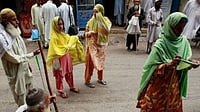Ever since the breakdown of the Nehruvian consensus that shaped the country after 1947, a growing number of scholars have agonised over the ‘idea of India’. In part, this concern was a response to the rise of Hindu nationalism and a fear that India was being transformed into something fearfully different. Equally, it was also an attempt to grapple with the changes a market economy, particularly globalisation, would herald.
Ananya Vajpeyi’s contribution to this debate is refreshingly different. It is neither a comprehensive political history nor a thorough dissection of the Indian mind. It draws from these as well as theology and aesthetics to paint a tantalising picture of the ferment that gripped leading Indian minds in the 20th century.
The book proceeds on the assumption that major historical developments are accompanied by an introspection of the self, both at an individual and collective level. India, in her view, experienced this process sometime after the Swadeshi movement hit a brick wall and the moderate-extremist divide led to Indian nationalism losing its momentum.
She believes that Mahatma Gandhi’s Hind Swaraj (1909), with its revolutionary re-interpretation of the ‘Indic tradition’, was a ‘Galilean’ moment for India. Focusing principally on the doctrine of ahimsa and his engagement with the Bhagwad Gita, Vajpeyi projects Gandhi as an unlikely politician: “Gandhi was engaged in the search for a strong and virtuous Indic self, not so much in the quest for normatively exercised political power (rajdharma)”.
In a similar vein, Vajpeyi hones in on Rabindranath Tagore’s ‘viraha’, his conscious detachment from history and his alienation from public life after his experiences with the Swadeshi movement. Tagore’s rejection of nationalism as a ‘menace’ and his advocacy of a ‘life of simplicity, contemplation, and the cultivation of the soul, an ethic of social cooperation and not economic conflict’ also contributed to the ‘Righteous Republic’.
Vajpeyi’s inclusion of both Gandhi and Tagore as towering individuals who nudged the evolving India in the direction of righteousness is understandable. A little more curious, however, is that she has also included Jawaharlal Nehru and B.R. Ambedkar in that category.
Ambedkar did engage with Indic traditions to evolve his very distinct version of neo-Buddhism centred on a partial reading of traditional Buddhism. But, as the author concedes, Ambedkar’s Buddhism was more instrumental and a way of detaching Dalits from Hinduism, but not from the Indian nation. Ambedkar, she writes, “took the Buddha as his guru, and yet, in some fundamental way remained tone-deaf to the Buddha”. Little wonder then that Ambedkarite neo-Buddhism was easily transformed into Ambedkar worship.
Likewise, Nehru “saw himself as the new Asoka” and appropriated the majestic symbols of the Mauryan Empire for the new Republic. But apart from this expedient use of the past, there was little in Nehru to suggest that his vision of modern India was based on any meaningful engagement with the Indic inheritance. Nehru certainly shaped modern India, but his contribution to a righteous ethos was feeble. Vajpeyi’s description of him as a ‘scholar-statesman’ may be valid but not on the terms she has employed for the others.
Overall, this is a book that is original, insightful and quirky. Its political message is unequivocal: the occasion for another Galilean moment to reforge the idea of India hasn’t yet come. Many Indians would disagree.



















_.jpg?w=200&auto=format%2Ccompress&fit=max)






